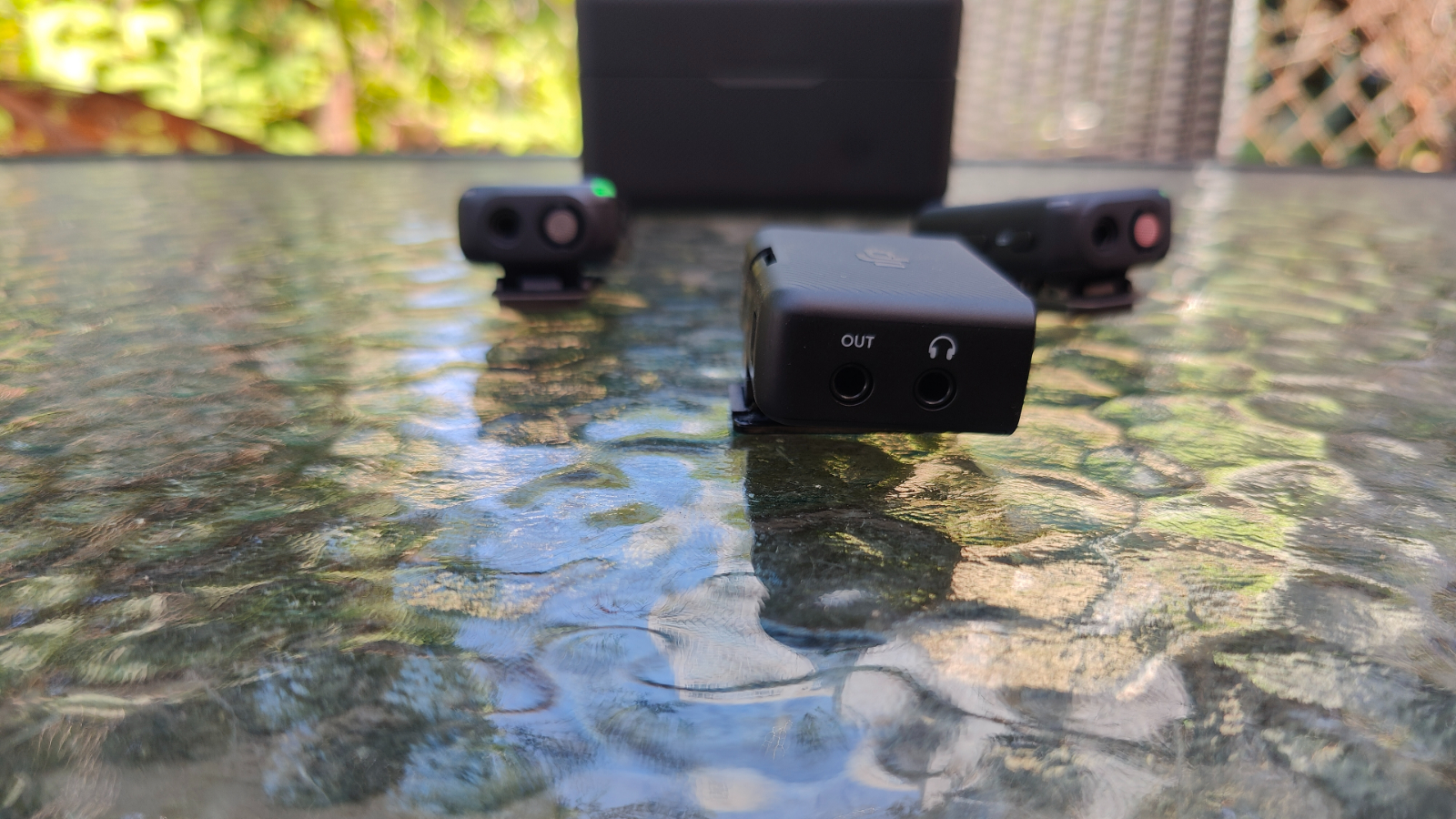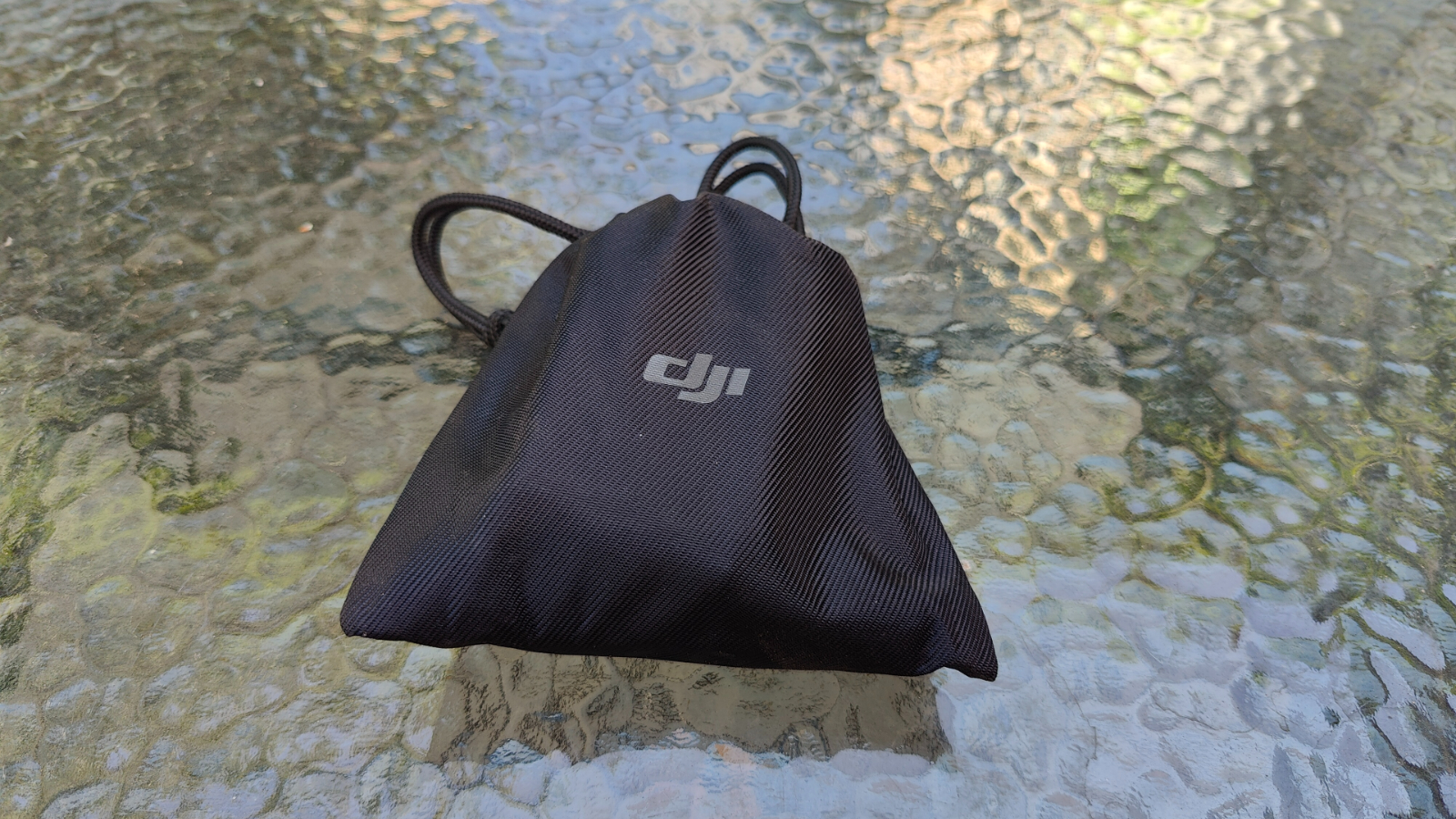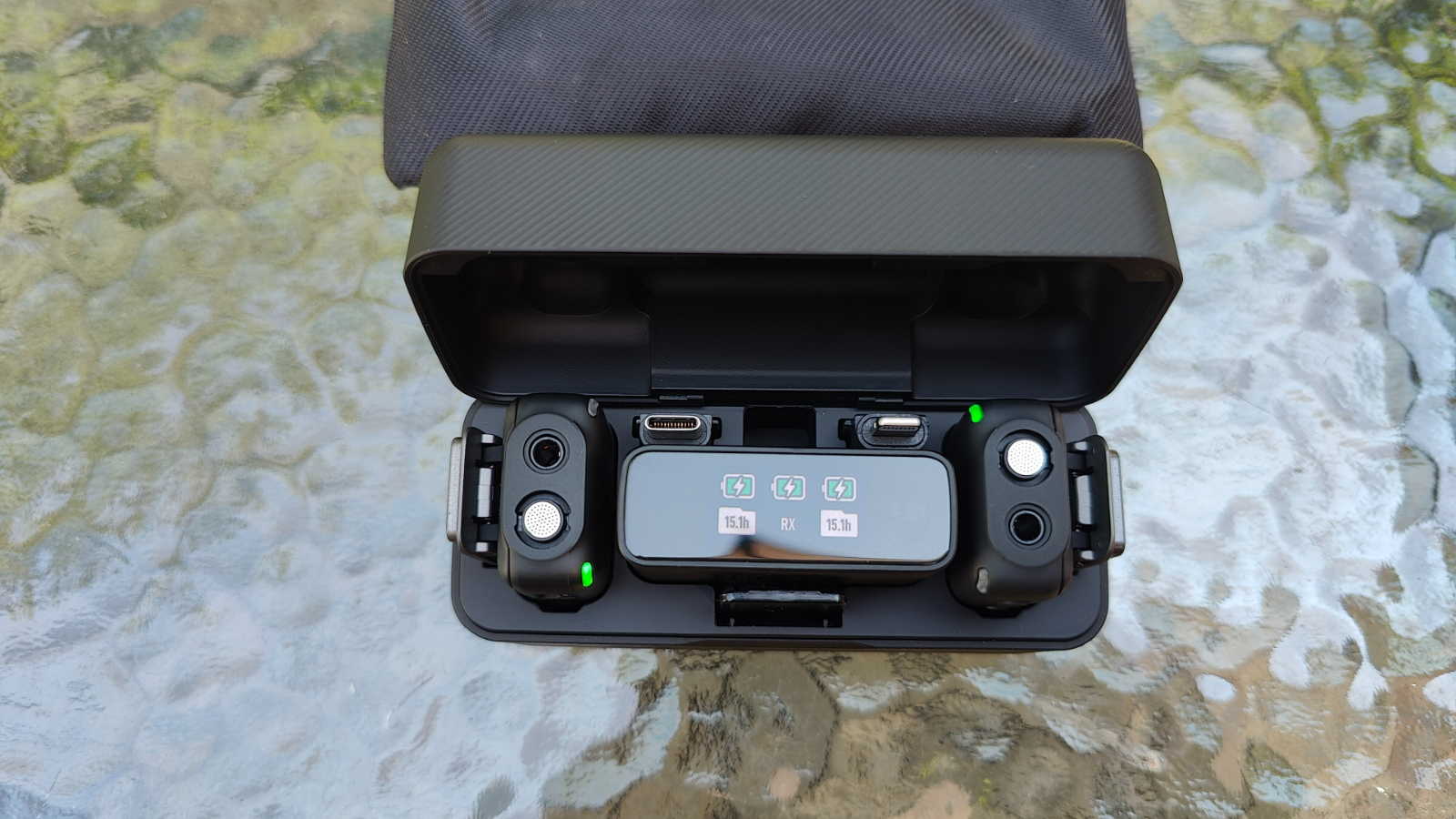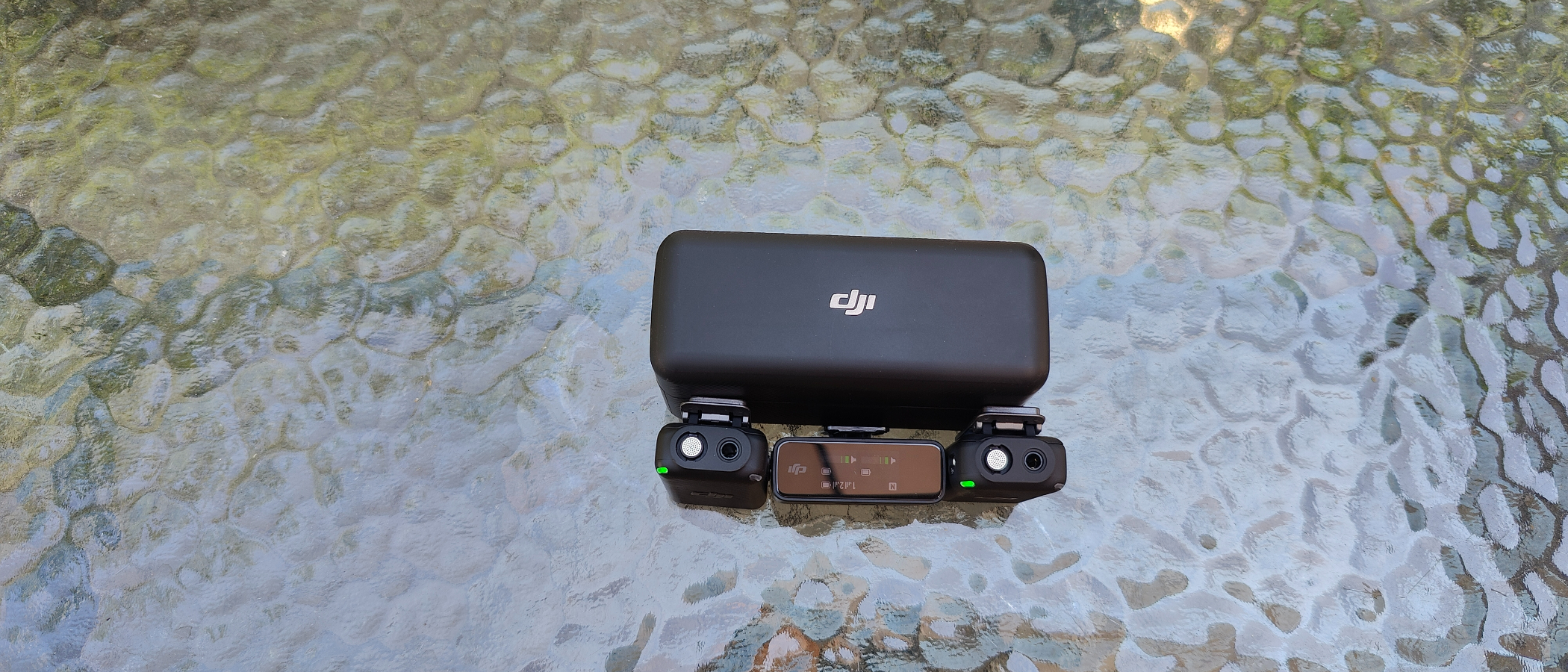Laptop Mag Verdict
The DJI mic is one of the best wireless mic systems available to content creators today. It records excellent audio, works across several devices and its charging case is fantastic.
Pros
- +
Excellent sturdy design
- +
820 feet transmission range
- +
Crisp, clean recordings
- +
Fantastic charging case and long-lasting battery
- +
Content creator-friendly
Cons
- -
Wish it came with lavalier mics
Why you can trust Laptop Mag
Price: $329
Microphone: Omnidirectional microphone
Frequency response: Low Cut Off: 50 Hz - 20 kHz Low Cut On: 150 Hz - 20 kHz
Weight: Transmitter 1.05 ounces Reciever 0.87 ounces Charger 5.7 ounces
Size: Transmitter 1.9 x 1.1 x 0.7-inches Reciever 0.7 x 1.8 x 1.3-inches
Battery Life: 5.5 Hours plus additional 10 hours via the charging case
Transmission Distance: Up to 820 feet
When I got my hands on the DJI Mic system ($329), I was intrigued to see if it could match the audio recording quality of the Rode Wireless Go II ($299). I immediately fell in love with its design and charging case. However, if the charging case is the only major difference between the two, is the extra $30 worth it?
Once fully charged, I grabbed my camera, went out, and started my testing. I quickly realized that I needed to make sure the gain was properly adjusted to avoid clipping and that the provided windscreen worked wonderfully. The control system is very user-friendly, and the self-charging case is brilliant, so yes, it’s worth the extra $30.

DJI thought of nearly everything, but a pair of lav mics would make this setup nearly perfect. Although the transmitters and receivers are fantastically lightweight and clip-on wherever you need them, their odd shape causes them to bend fabric and makes them difficult to hide while filming. I know I am being persnickety about this one tiny issue because, overall, the DJI Mic rivals the Rode Wireless Go II and is an excellent wireless setup for content creators.
Alright, enough preamble; let’s have a look at how things went and see if the DJI Mic is the right choice for your audio needs.
DJI Mic price and availability
The DJI Mic with charging case costs $329 and comes with two transmitters, one receiver, the hard plastic charging case, and a set of cables that allow you to connect to a computer, camera, or smartphone. You get a USB-C to USB-A cable, a USB-C to USB-C cable, USB-C to Lightning cable, and a single 3.5mm cable. So from the outset, you can connect the DJI mic to anything you need. However, iPhone owners should be aware that it will only record in mono to an iPhone, making it a poor partner for iPhone owners looking for a high-quality audio option.

The included charging case extends the overall battery life of the system, and itself is easily charged via USB-C from an adapter, computer, or external battery so you can have power all day.
Sign up to receive The Snapshot, a free special dispatch from Laptop Mag, in your inbox.
If you’re on a tight budget, and just need to have a wireless recording option that’s affordable with excellent connectivity, I would look into the Razer Seiren BT wireless mic we recently reviewed that costs $99.99. If you have a bigger budget, you could also look into the Rode Wireless Go II for $299.
DJI Mic design
The DJI Mic Receiver screen is easy to use, but sometimes, it’s temperamental, although my gigantic sausage fingers don’t help. Once you figure out the swiping motions needed to move around within the unit, you’ll find yourself making quick adjustments on the fly. It becomes a snap to switch from mono to stereo or select which transmitter will be your right or left mic. Simply tap the power button to lock and unlock the screen, which is a nice feature that speeds things up for creators and avoids accidental presses. When looking at the screen, it displays the input levels of both mics, allowing you to monitor your audio levels, and on the side, you will find the 3.5mm audio jack.

The transmitters are tiny and aesthetically pleasing and clip onto clothing quickly and easily. I really like that the clips magnetically attach to the units and can also be used as another method for clipping them to subjects or metal surfaces. Again, it can be difficult to conceal them, but given how small and unobtrusive they are, if it’s an interview or if you are a solo YouTube creator, then having the receiver in the shot probably isn’t a big deal. The kit also includes two windscreens that pop on or off the receivers and do an excellent job at baffling wind noise and unwanted background audio.

DJI did another really nice thing. They made the clips the right size so they will fit in your camera's hot shoe snuggly so you can just pop it in and mic your subject and start recording. The DJI Mic's overall design is fantastic and well thought out, and the charging case really makes it a true all-in-one device as it houses everything you need.

It also comes with a soft case so you can keep your DJI mic system protected; nice work DJI, I see you.
DJI Mic audio quality
From an audio perspective, the DJI Mic does everything a content creator would need it to do. Does it record excellent audio? Yes, it does. Does it allow you to record your subject's audio from a distance of 820 feet (250 meters)? Yes, but be mindful that you want to be within a direct line of sight. To test this, I set up my camera and walked more than a fair distance away while recording a conversation I was having with the cameras as if I were about to interview someone and we were meeting in the park. The audio remained clear and the signal was strong until I crossed paths with some trees but, I was a great distance away.

Also, as I previously mentioned, the windscreens do an excellent job, so you get wonderfully clear audio recordings. I did find myself having to make several adjustments to get my recordings just right as the gain on the DJI is very sensitive, at times overcompensating. So always test your audio levels before you actually start filming. It’s not a failing of the device; it’s a good thing the mics are so sensitive, but test, adjust, and you’ll enjoy great recordings.
I learned while filming in the park that I could use the receiver’s touchscreen to activate a safety channel mode, which is a separate track that records at 6db and helps to prevent your audio from sounding blown out and gives you that separate track as a backup. The Rode Wireless Go II has a similar feature, but you need to access it via the Rode app.
While in the park, I recorded an on-the-spot interview with a stranger by simply clipping the mic to them. Although they found the windscreen annoying, the recording was excellent as it captured the person's high, nasal-toned voice crisply alongside my deeper timbre as we exchanged responses. I later used the DJI Mic, which I connected to my OnePlus Pro 10, and recorded a test podcast in my backyard with the mic clipped to my t-shirt. After making adjustments for some clipping, it really was a sharp, super clear recording with the mic focusing on my deep clear voice, and not catching too much of the aviary that my backyard becomes in the afternoon.
DJI Mic software
DJI is down with the universe's plug-and-play gods, so no downloads are needed to work with the system. It works well with all my recording software across all devices I used it on. DJI does roll out frequent firmware updates to improve the performance of its wireless mic system, so make sure to look out for those.
DJI Mic battery life
The DJI Mic’s receiver and transmitter units are rated for 5.5 hours of battery life and since I am a chatty, long-winded annoyance, I tested this out and it’s true. I easily got five plus hours out of the system before needing to charge. However, let me point out that, thanks to the ten hours of additional battery life from the charging case, you’re going to get all-day use out of the DJI mic.

I got a good seventeen plus hours of recording out of the system because nobody talks for ten hours straight — even me. Also, you will find yourself between takes when you’re moving to a different location, putting the transmitters and receiver into the case as you move along, so with those little top ups throughout the day, the battery life should never be a problem.
The charging case is a game changer and the one clear-cut advantage it has over the Rode Wireless Go II system, (although there is a well-liked third-party charging case for the Go II) that pushed the DJI a little ahead.
Bottom Line
The DJI Mic is definitely one of the best wireless mic systems I’ve used. I know you want to know my ultimate decision between it and the Rode Wireless Go II, but honestly, it all comes down to what you need and what you value most. The DJI Mic produces excellent recordings. Its battery life, thanks to the charging case, is outstanding and worth the $30 price bump versus the Rode if you have it in your budget.
The user-friendly touchscreen and UI are good, too, but require a small learning curve. I found the audio in most cases near to the quality of the Rode Wireless Go II, but it required more fine tuning. So, in the end, it’s really toss-up and a matter of preference on the few differentiating factors. If you have the funds, and you want to record pro-level audio on the go, the DJI Mic is one of the two best systems available and I absolutely recommend it.

Mark has spent 20 years headlining comedy shows around the country and made appearances on ABC, MTV, Comedy Central, Howard Stern, Food Network, and Sirius XM Radio. He has written about every topic imaginable, from dating, family, politics, social issues, and tech. He wrote his first tech articles for the now-defunct Dads On Tech 10 years ago, and his passion for combining humor and tech has grown under the tutelage of the Laptop Mag team. His penchant for tearing things down and rebuilding them did not make Mark popular at home, however, when he got his hands on the legendary Commodore 64, his passion for all things tech deepened. These days, when he is not filming, editing footage, tinkering with cameras and laptops, or on stage, he can be found at his desk snacking, writing about everything tech, new jokes, or scripts he dreams of filming.

